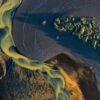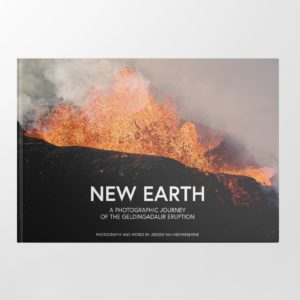To celebrate the one year anniversary of the eruption in Geldingadalir, I decided to create a timeline showing all the events which happened during this eruption. It’s by no means meant as a geological or scientific account of things but more as a visual guideline and memento dedicated to this incredible experience. It’s combined with some of my favourite photographs taken during this eruption. Enjoy!
February 24th 2021 - An Earthquake Swarm Begins
At the end of February 2021, an earthquake swarm kicks off close to Keilir on the Reykjanes Peninsula. This area had been hit with several other earthquake swarms before but none that lasted for such a long time. What was especially curious about this swarm, was that the epicentre of the earthquakes seemed to be moving towards the southwest. The biggest quake in the area had magnitude 5.7.
On March 3rd, harmonic tremor is measured for the first time. As this is usually a precursor for an eruption, scientists believed one to be imminent. However, the harmonic tremor subsided and no eruption followed. At this time, it also became clear that a magmatic dyke had formed seemingly indicating an eruption was imminent.
Roughly a week later, an earthquake of magnitude 5.4 hit the area. Interestingly enough, almost all activity seized after that quake leading almost everyone to believe that the activity had subsided completely.
Source: Veðurstofa Íslands
March 19th 2021 - The Eruption Begins
On the evening of March 19th, an eruption began in Geldingadalir. Curiously enough, it was first noticed by people driving along Reykjanesbraut and not by the measuring equipment in the area. They noticed an odd red glow in the mountains. While it is assumed the eruption began around 9pm, it’s likely the eruption has already began before it was noticed.
It turned out to be a rather small eruption and initially it was thought that the eruption might be a short-lived one, lasting maybe a matter of days. Initially four vents formed but only two of them sustained throughout the night.
The second day, when it became clear how to approach the eruption, a handful of people hiked to the area. The hike was strenuous and long as there were no trails in the area. On the third day, about a thousand locals visited the eruption before a storm set in. It was a big and happy gathering, feeling a lot like an outdoor festival of some sorts.
The following days, the valley started filling with lava and a big lava lake formed around the vents. Additionally, the two vents grew out to become two big craters in just that first week. Several thousand people hiked to the area to witness the spectacle and quickly proper hiking trails and improvised parking lots were created to deal with the traffic that came with it.
Into the second week of the eruption, the craters collapsed in on themselves and the vents seemed to be drowning in their own lava output. On April 4th, the lava output decreased a lot. This led several geologists to believe the eruption might have come to an end but exactly the opposite was true…
April 5th 2021 - a New Fissure Opens Up Towards the North
Around noon on April 5th, a new fissure opened up north of the active vent system. The area was quickly evacuated and closed off as no one knew what was going to happen next. Several hours later, another fissure opened parallel to the first one. The following day, another smaller fissure opened up in-between the original and the northernmost vent system. The area remained off-limits for everyone until it was determined that the changing behaviour had stabilised.
On April 7th, the area opened up for the first time after the new fissures opened up. Due to the bad weather conditions and gas accumulation, very few people went there on that day.
April 7th to 13th 2021 - Several New Vent Systems & Craters Are Formed
From this point on, the eruption would change very dramatically every few days. Several new vents opened up and the lava flow increased drastically in comparison to the first phase of the eruption.
On April 10th, a fourth vent system appeared just south of the northernmost crater. Just a few days later, on April 13th, two new vent systems appeared. Vent system number 5, which was closest to the original vents, started to quickly overtake everything, closing off the only passage to get close to those craters within days after appearing.
On the morning of April 15th, it was deemed too dangerous to allow people to walk closer to the craters due to risk that the only path in and out of the area would be closed off. Later that day, passage there was cut off by the flowing lava.
One by one, the newly formed vent systems started shutting down and activity started consolidating into vent system number 5.
May 1st 2021 - Only One Vent Remains Active & Starts Pulsating
Vent system number 5, the latest one to have formed in this eruption, becomes the only one to remain active. During the night of May 1st and May 2nd, the behaviour of the eruption changes. Where it was constantly erupting, it now changed into a pulsating pattern. Every 5-10 minutes, it would erupt to great heights after which it would recharge. At times, it could reach 450 metres in height. The lava fountain was often visible from Reykjavík.
Later into May, the lava fountain stopped reaching such incredible heights though the pulsating behaviour continued until the end of June. The crater kept growing in height. Towards the end of May, the inside of the crater became big enough to house a lava lake. The exit point, where the lava flowed out of the crater, turned into a big lava fall.
On May 31st, the closest viewing hill (Gónhóll) was closed off as it was feared the lava would overtake the path towards it. Just a few days later, the hill gets cut off by a lava flow. Shortly after that, the secondary viewing hill and hiking path A gets cut off by a lava flow exiting Geldingadalir. Most people start hiking up Langihryggur instead, creating path C in the process.
Authorities feared the road towards the southern end of the lava field would soon be destroyed by the new flow.
June 28th 2021 - The Eruption's Behaviour Changes Into Longer Cycles
On June 28th, the eruption’s behaviour changed dramatically. The eruption went dormant for many hours and started up again the next day. On July 2nd, the eruption almost continuously erupted very large amounts of lava from the crater for hours as if it had been held back due to the break in activity.
From this point on, the eruption was active sporadically. Most of the time the period of inactivity lasted anywhere from 24 to 48 hours, followed by a period of 16-20 hours of activity. The only way to determine when the eruption would become active was to keep a close eye on the seismic data being gathered in the area. Many believed the eruption was either getting close to the end or that several blockages occurred in the newly formed magma intrusion, possibly caused by the weight of the lava on top.
The changes in activity also helped the lava find a new escape route, towards Meradalir in the east. This meant the lava field stopped expanding towards the south, sparing the road. When the lava flowed into Meradalir, a big lava fall would appear.
The erratic behaviour of the eruption continued on until September 1st.
September 2nd 2021 - The Eruption Becomes Dormant
On September 2nd, the eruption became dormant. No one is really sure why the vent went dormant but one theory is that the vent got blocked after earthquake activity closed the tunnel. Another theory is that the pressure within the magma intrusion dropped significantly.
September 11th 2021 - The Eruption Starts Again After a 9-day Hiatus
Much to everyone’s surprise, the eruption began again after a 9-day hiatus. It seemed like something blocked the magma intrusion causing the lava to search for a new path to the surface. Once it did, the magma came up in the middle of the crater wall. This caused the wall to be split in two. Several secondary vents seemed to open in the lava field to the north east of the crater.
During the days that followed, the eruption did not slow down at all. Lava kept on flowing and a huge lava river formed in Geldingadalir. The lava output was so great, it looked like the lava was going to flow out of Geldingadalir into Nátthagakriki towards Svartsengi.
On September 18th, the visible activity seized and the eruption went dormant again.
September 18th 2021 - The Last Day of Visible Activity
December 18th 2021 - The Eruption Is Officially Declared Over
Exactly three months after the last visible activity was seen at Geldingadalir, the eruption was officially declared over.
Interestingly enough, just a few days after that underground activity resumed and a new magma intrusion seemed to try and breach the surface. According to radar imagery, magma had reached a depth of one kilometre. This led many to believe a new eruption was imminent. However, after a few weeks, all activity seized and no new eruption happened.
My Top 5 Moments
Last year I had a once-in-a-lifetime opportunity to experience a volcanic eruption up-close in a way that has rarely been possible. I visited the Geldingadalir eruption of the Fagradalsfjall volcanic system in Iceland over 44 times. During those visits, I spent many hours photographing and documenting the eruption. In this video, I share my 5 most memorable moments and show some of my work surrounding this incredible volcanic event.
New Earth: My Book About the Eruption
In December 2021, I self-published a book about the eruption in Geldingadalir “New Earth” became a uniquely personal, photography- and experience-focused book covering the recent volcanic eruption in Geldingadalir from the first until the last day it was active.
What People Are Saying About New Earth
“This has to be the ‘go to’ book on a crazy last 9 months in an even crazier country. The photography is incredible but the words that go with it is where Jeroen has taken it to the next level.” – Jacob
“It is excellent how it captures the feelings, moments and thoughts that also I had during the time at the volcano.” – Glacionaut
“I kept saying “wow” throughout! A fantastic book for anyone who visited Geldingadalir, wanted to but couldn’t, or anyone with a passion for volcanoes who’d appreciate witnessing the story of this incredible eruption. Magical!” – Lesley
“Highly recommended from someone who has had the chance to experience over 15 volcano eruptions and owns 45 books about volcanoes, so I can safely say that I can distinguish the wheat from the chaff.” – John
A New Eruption at Fagradalsfjall in 2022
In August 2022 a new volcanic eruption started at Fagradalsfjall on the Reykjanes Peninsula in Iceland. The eruption took place in Meradalir, a lower valley in the area. It was initially much larger than the first one. I was very lucky and privileged to visit the area within the first few hours of the eruption and 5 times after that.
The Fagradalsfjall Fires
Because there have been two eruptions at Fagradalsfjall in such a short time, people have started calling them the Fagradalsfjall Fires (Fagradalsfjallseldar). This homage to the Fagradalsfjall Fires is a collection of video footage made during the two eruptions at the Fagradalsfjall volcano in Iceland. This footage has been captured over the course of 7 months during both the Geldingadalir and Meradalir eruptions in 2021 and 2022.
Support Jeroen’s Work
As an independent photographer, Jeroen partially relies on your support to keep producing worthwhile content such as blogs, photographs, books and much more. If you want to support his work, it is possible to do so by buying his e-books & books, prints or calendars.
You can also sign up to the newsletter to stay up to date on new blog posts, projects, workshops and other interesting information.
Thank you for considering!




















































































